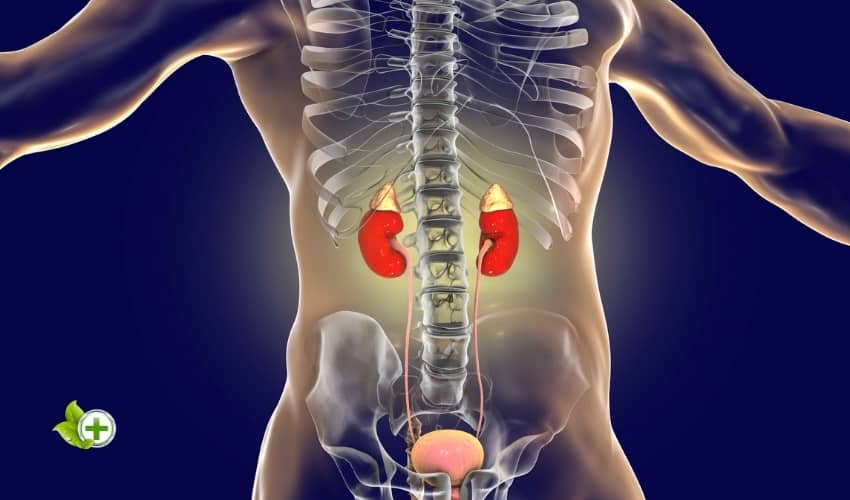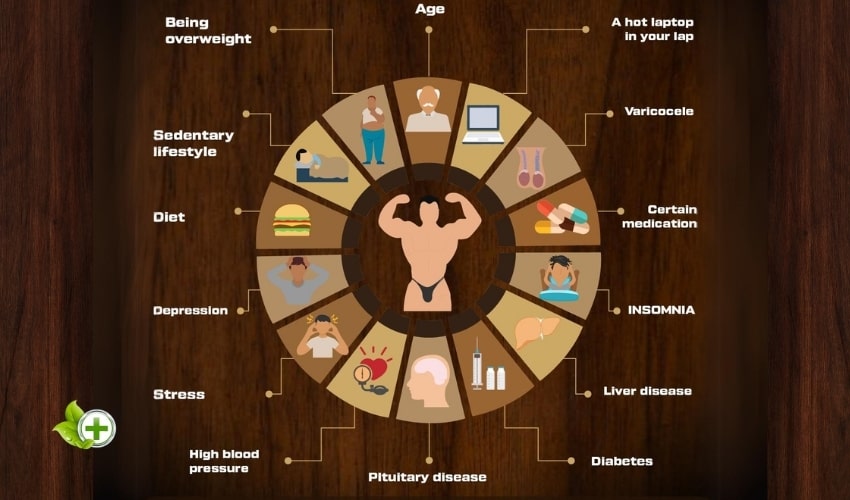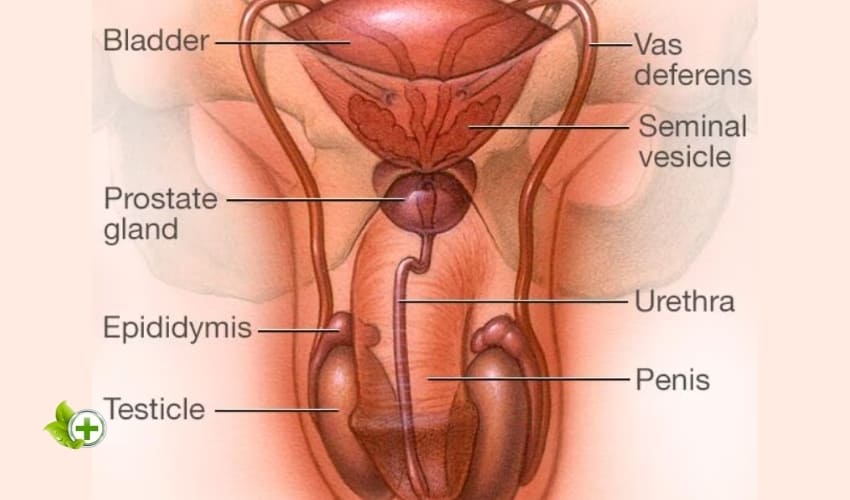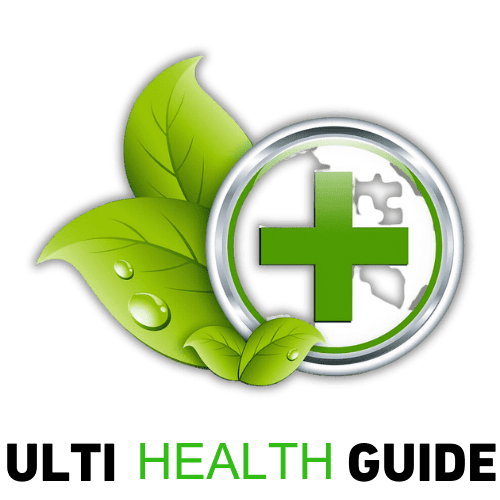What Is Testosterone?
Testosterone is a male sex hormone produced primarily in the testes in men and in smaller amounts in the ovaries and adrenal glands in women.
It is responsible for developing male sex organs, secondary sexual characteristics such as facial hair, muscle mass and strength, and sperm production. Testosterone levels peak during adolescence and early adulthood, then decline with age.
Understanding Testosterone Levels
Children 7-10 years old: Males (1.80-5.68 ng/dL)/Females (2.69 to 10.29 ng/dL)
Adolescents 13–18 years old: Males (208.08 to 496.58 ng/dL)/Females (16.72 to 31.55 ng/dL)
Adults 20 yrs and older: Males (295-1020 ng/dL)/Females (15-70 ng/dL)
What Causes Low Testosterone Levels?
- Aging
- Injury or disease of the testicles
- Tumors or injury of the pituitary gland or hypothalamus
- Genetic disorders
- Medications
- Obesity
- Chronic illness
How to Test Your Testosterone Levels
Testosterone levels can be measured with a simple blood test. The test is typically done in the morning when testosterone levels are the highest. The doctor may also repeat the test on different days to confirm the results.
What Is Hypogonadism?
Hypogonadism, also known as testosterone deficiency, is a medical condition in which the body doesn't produce enough testosterone. This can occur in men and women, but it is most common in men.
What Causes Low Testosterone Levels?
- Aging
- Injury or disease of the testicles
- Tumors or injury of the pituitary gland or hypothalamus
- Genetic disorders
- Medications
- Obesity
- Chronic illness
Symptoms of Low Testosterone (Male Hypogonadism)
- Low sex drive
- Erectile dysfunction
- Fatigue
- Loss of muscle mass and strength
- Increased body fat
- Decreased bone density
- Hot flashes, night sweats
- Emotional changes
Treatment for Hypogonadism in Males
- Testosterone replacement therapy
- Clomiphene citrate
- Human chorionic gonadotropin (hCG)
- Anabolic steroids
What Is Hypergodanism?(High Testosterone & Estrogen)
Hyperandrogenism is a medical condition characterized by excessive levels of androgens, the male sex hormones, in the body. This can occur in both men and women.
What Causes High Hypergodanism levels?
- Polycystic Ovary Syndrome (PCOS)
- Congenital Adrenal Hyperplasia (CAH)
- Ovarian or Adrenal Tumors
- Hyperthecosis
- Cushing's Syndrome
- Androgen-secreting tumors
- Medications
Complications Caused by Hypergonadism
- Infertility
- Hirsutism
- Acne
- Irregular menstrual cycles
- Metabolic disorders
- Insulin resistance
- Male-pattern baldness
- Depression and anxiety


- NatureBell DHEA 100mg, 240 Capsules | Extra Strength, Micronized Grade for Better Absorption, Supports Energy Level, Metabolism and Healthy Aging for Men and Women, No GMOs and Made in U.S.A

- Life Extension DHEA 25 mg – For Optimal Hormone Balance, Immune & Cardiovascular Health and Anti-Aging – Promotes Healthy Mood & Well-Being - Non-GMO, Gluten-Free, 100 Capsules

- DHEA 100mg | 200 Capsules | Non-GMO, Gluten Free Supplement | by Horbaach
It all begins in the hypothalamus, a small, but influential gland in the brain between the pituitary gland and the thalamus. It is also known as the master gland which not only plays an important role in hormone production but also stimulates many important processes in the body.
The hypothalamus releases the hormone gonadotropin, which instructs the pituitary gland in the brain to release LH (Luteinizing hormones) and FSH (Follicle-stimulating hormones).
In men, a brain-driven process enhanced pituitary LH secretion that specifically stimulates the production of testosterone in the testes. It does this by stimulating a special type of cell, called a Leydig cell within the testes. The activated Leydig cells (about 500 million of them) convert cholesterol into testosterone. Testosterone is then secreted by the testicles of males. The FSH hormone on the other hand is also influenced by a Leydig cell which is involved in sperm production and plays a part in the development of the gonads(gonads refers to both male testicles and female ovaries).
In women, the pituitary gland sends out LH during the ovulation part of the menstrual cycle which tells the ovaries to release a mature egg. The FSH hormone is responsible for the growth of ovarian follicles, produces estrogen and progesterone in the ovaries, and helps to maintain menstrual cycles in women. In short, Testosterone is made in the testes of men, the ovaries of women, and the adrenal glands.

How is testosterone produced in the body?
It all begins in the hypothalamus, a small, but influential gland in the brain between the pituitary gland and the thalamus. It is also known as the master gland which not only plays an important role in hormone production but also stimulates many important processes in the body.
The hypothalamus releases the hormone gonadotropin, which instructs the pituitary gland in the brain to release LH (Luteinizing hormones) and FSH (Follicle-stimulating hormones).
In men, a brain-driven process enhanced pituitary LH secretion that specifically stimulates the production of testosterone in the testes. It does this by stimulating a special type of cell, called a Leydig cell within the testes. The activated Leydig cells (about 500 million of them) convert cholesterol into testosterone. Testosterone is then secreted by the testicles of males. The FSH hormone on the other hand is also influenced by a Leydig cell which is involved in sperm production and plays a part in the development of the gonads(gonads refers to both male testicles and female ovaries).
In women, the pituitary gland sends out LH during the ovulation part of the menstrual cycle which tells the ovaries to release a mature egg. The FSH hormone is responsible for the growth of ovarian follicles, produces estrogen and progesterone in the ovaries, and helps to maintain menstrual cycles in women.
In short, Testosterone is made in the testes of men, the ovaries of women, and the adrenal glands.

Understanding Testosterone Levels
Normal testosterone levels are about seven to eight times greater in adult males than in adult females. This hormone is responsible for the development of male characteristics such as muscle mass and body hair, and also plays a role in the production of sperm. Testosterone in both sexes is involved in health and well-being, including moods, behavior, and the prevention of osteoporosis(a condition in which the bones become brittle and fragile from loss of bone tissue). It may also play a role in red blood cell production and iron metabolism that helps with the forming of hemoglobin that supports the transportation of oxygen in red blood cells. Testosterone levels peak during puberty and begin to decline around the age of 30.
Balanced Testosterone levels are necessary for optimal health and growth, no matter your sex.
During puberty (11 -15 years old), testosterone helps boys develop male features like body and facial hair, deeper voice, and muscle strength. Men need testosterone to make sperm. Testosterone levels generally decrease with age, therefore older men tend to have low testosterone blood levels.
The following list show testosterone levels in children, adolescents, and adults. (nanograms per deciliter: ng/dL):
- Children: 7-10 years old: Males (1.80-5.68 ng/dL)
- Children: 7-10 years old: Females (2.69 to 10.29 ng/dL)
- Adolescents:13–18 years old: Males (208.08 to 496.58 ng/dL)
- Adolescents:13–18 years old: Females (16.72 to 31.55 ng/dL)
- Adults 20 yrs and older: Males (295-1020 ng/dL)
- Adults 20 yrs and older: Females (15-70 ng/dL)

What Causes Low Testosterone Levels?
A testosterone level dip is a common phenomenon in aging men. When low testosterone levels are experienced by men, it is called Testosterone Deficiency Syndrome (TD) or Low Testosterone (Low-T). Deficiency means that the body does not have enough of a needed substance. Testosterone Deficiency Syndrome is a group of symptoms that, together, suggest a disease or health condition.
The American Urology Association (AUA) identifies low blood testosterone (Low-T) as less than 300 nanograms per deciliter (ng/dL) in adult men. It can be caused by a number of conditions, including:
- Testicular cancer.
- Injury to the testicles.
- Hormonal disorders.
- Treatment for testicular cancer.
- Infection.
- HIV/AIDS(suppressed immune system)
- Chronic liver disease.
- Chronic kidney disease.
- Type 2 diabetes. (Read more on Type 2 Diabetes here: Diabetes Fully Explained)
- Obesity.
- Alcohol abuse.
- Certain medications.
- Age (in men older than 30, testosterone production start slowing down)

How to Test Your Testosterone Levels?
A fast amount of the testosterone in your blood attached itself to two proteins namely albumin and the sex hormone-binding globulin (SHBG). Some of the testosterone available is free and not attached to proteins. These free testosterone and albumin-bound testosterone are also referred to as bioavailable testosterone and can easily be used by your body.
When you have low or high T-levels, your healthcare provider will first test your total T-levels. There are two main types of testosterone tests that may be used to determine levels of testosterone:
- Total testosterone test, which measures both the attached and free testosterone.
- Free testosterone test, when only free testosterone is measured.
If your total testosterone is too low or too high, a Free-T test can provide more information on your problem and certain medical conditions like:
- Erectile dysfunction in men
- Testicular cancer in men
- Decreased sex drive in both sexes.
- Infertility in both sexes.
- Irregular menstruation in women.
- Development of masculine features in women.
- Delay or early puberty in boys.
Procedure to do a Testosterone Levels Test
A blood sample from a vein in your arm will be taken by a healthcare professional. A small amount of blood will be collected into a vial and sent to a lab for testing.
Explanation of Test Results
Results mean different things depending on gender.
Males:
- High T levels (too much testosterone) may indicate a tumor in the adrenal glands and testicles. Adrenal glands help control heart rate, blood pressure, and other bodily functions.
- Low T levels may mean a genetic or chronic disease or a problem with the pituitary gland.
Females:
- High T levels may indicate a condition called polycystic ovary syndrome (PCOS) which is a common hormone disorder affecting women of childbearing age. This is a leading cause of female infertility.
- High T levels may also indicate cancer of the ovaries or adrenal glands.
- Low T levels are normal, but extremely low levels may indicate a disorder of the pituitary gland. (Addison disease)
Boys:
- High T levels can indicate cancer in the testicles or adrenal glands.
- Low T levels can suggest a problem with the testicles which might include an injury.
In some cases, abnormal results don't necessarily mean you have a medical condition that needs treatment. Some medicines and alcoholism problems can have an effect on test results.

What is Hypogonadism? (Low Testosterone level)
Hypogonadism is a condition in which the gonads produce little or no sex hormones. This causes lower than normal levels of testosterone and estrogen. If your testosterone level becomes critically low, bone mass is lost over time.
What Causes Low Testosterone Levels?
There are two causes of low testosterone in males and females. The primary cause lies in the (testes or ovaries) and the secondary cause (is manifested within the pituitary- or hypothalamus gland).
A testosterone level dip is a common phenomenon in aging men and when low testosterone levels are experienced by men, it is called Testosterone Deficiency Syndrome (TD) or Low Testosterone (Low-T). Deficiency means that the body does not have enough of a needed substance. Testosterone Deficiency Syndrome is a group of symptoms that, together, suggest a disease or health condition.
The American Urology Association (AUA) identifies low blood testosterone (Low-T) as less than 300 nanograms per deciliter (ng/dL) in adult men.
Low-T can be caused by a number of conditions, including:
- Failure of the gonads, (testes in men and ovaries in women), which then produces little or no hormones. (the production of a man's testosterone and a woman's estrogen is inhibited). Low testosterone production plays a key role in masculine growth, male development during puberty and adulthood, cognitive function, and even fetal development. Hypogonadism in females is caused by the disruption of any section of the hypothalamic-pituitary-ovarian axis pathway.
- Mumps orchitis can also cause an increased risk of male hypogonadism A mumps infection of the testicles (during adolescence or adulthood) can damage the testicles. Mumps orchitis can affect sperm production as well as testosterone production.
- Hereditary hemochromatosis is a genetic disease that progresses silently and is often diagnosed late. Hypogonadotropic hypogonadism (HH) is one of the complications of hemochromatosis. Symptoms linked to HH can impact a patient’s sexuality, such as erectile dysfunction, decreased libido, and impairment. It can also influence reproductive capacities.
- Kallmann syndrome: A genetic condition where puberty either fails to begin or doesn’t complete.
- Pituitary disorders: Includes problems with how the pituitary functions. It can also be caused by a pituitary tumor or brain tumor. Radiation can cause long-term damage to the pituitary gland.
- Klinefelter syndrome. (is a genetic condition that results when a boy is born with an extra copy of the X chromosome. It may adversely affect testicular growth, resulting in smaller than normal testicles, which can lead to lower production of testosterone.
- Cryptorchidism. (Undescended testicles). A testicle that hasn't moved into its proper position in the bag of skin hanging below the penis (scrotum) before birth.
- Injury and or interrupted blood supply to the testicles.
- Infection of the testes.
- Chemotherapy for Cancer.
- Certain medications treat infections caused by fungi or yeast.
- In women, loss of ovary function through disease or surgery, an underactive pituitary gland, and medicines such as corticosteroids or estrogen can all cause low testosterone levels.
- Hyperthyroidism (Overactive thyroid).
- Tumors in the ovaries or testes (benign or malignant).
- A pituitary tumor or other type of brain tumor located near the pituitary gland may cause testosterone or other hormone deficiencies
- Alcohol abuse.
- Age (in men older than 30, testosterone production start slowing down)
Symptoms of Low Testosterone (Male Hypogonadism)
- Low sex drive and Erectile dysfunction
- Reduced fertility.
- Low sperm count.
- Depression.
- Sleep disorder.
- Decreased strength and energy.
- Facial and body hair loss.
- Muscle mass loss.
- Loss of bone density.
- Growth and sexual development may be impacted if the onset is before puberty.
- A deficiency of testosterone during fetal development may result in impaired growth of the external sex organs. Depending on when hypogonadism develops and how much testosterone is present, a child who is genetically male may be born with genitals that are neither clearly male nor clearly female (ambiguous genitals), female genitals, or in some cases, underdeveloped male genitals.
Treatment for Hypogonadism in Males
- Testosterone replacement therapy and or testosterone supplementation.
- Procedures to assist with infertility.
Symptoms of Female Hypogonadism
- Muscle weakness.
- Fatigue.
- Absence of menstruation.
- Sleep disorder.
- Reduced sex drive and sexual function.
- Weight gain.
- Fertility issues.
- Slow or absent breast growth.
- Hot flashes.
- Loss of body hair.
- Milky discharge from breasts.
- Depression.
- Mood swings.
Treatment for Hypogonadism in Females
Hormone replacement therapy: Increasing levels of estrogen and progesterone assist in strengthening bones, improving cholesterol levels, and supporting a woman's sex drive.
Assistance in reproduction
- Assisted reproductive technology (ART): Fertility treatment in which either eggs or embryos are handled.
- In vitro fertilization (IVF): IVF involves extracting a woman's eggs and fertilizing the eggs in a laboratory. The resulting embryos are then transferred through the cervix into the woman's uterus.
- Gamete intrafallopian transfer (GIFT): Multiple eggs are collected from the woman's ovaries and placed into a catheter together with the donor's sperm. Both eggs and sperm are then injected into the fallopian tubes by way of a laparoscopy.

What is Hypergodanism?(High Testosterone & Estrogen)
Hypergonadism is a condition in which the gonads have an overproduction of hormones. A direct result of hypergonadism is abnormally high levels of testosterone and estrogen.
What causes High Hypergodanism levels?
In woman:
- Hirsutism, polycystic ovary syndrome.
- PCOS (Polycystic Ovary Syndrome), is a hormonal disorder that causes high testosterone levels in your blood.
- Steroid use and abuse. can hike up your testosterone levels and hormone levels of other androgens
- Adrenal disorders (congenital adrenal hyperplasia), are genetic and often found at birth or during puberty.
In men:
- Tumors: Adrenal and testicular tumors.
- Anabolic steroid abuse
Complications caused by Hypergonadism
Aside from acne and other physical changes, such as facial hair on women and more breast tissue in men, hypergonadism can cause some more serious complications.
Hypergonadism can interfere with regular menstrual cycles. That can make it difficult for women to become pregnant.
Generally, the complications associated with hypergonadism are related to the underlying cause. Treating the cause may help reduce symptoms and complications brought on by hypergonadism.
When to seek help
If you notice precocious puberty in your child or physical changes in yourself that may be related to hormonal abnormalities, discuss your concerns with a doctor. If hypergonadism is suspected, your doctor may order a blood test to see if hormone levels are unusually elevated. Additional tests might include a pelvic ultrasound to get a more detailed view of the adrenal glands and the ovaries. Brain imaging may be done to look for tumors of the pituitary gland.
Treatments for Hypergonadism
Treating hypergonadism is difficult. The goal is to reduce hormone levels, which is more difficult than trying to increase hormone levels.
The hormonal treatment that is administered for hypergonadism includes a combination of hormones tailored to your particular levels. This can be a slow process. It may take some time to find the right mix of hormones at the right dosages.
If a specific cause can be diagnosed, then treatment will also focus on caring for that condition. If a gland has a tumor, for instance, it may be necessary to surgically remove the tumor. If the cause is a severely underactive thyroid, you may be prescribed strong doses of thyroid medication to help restore healthier body chemistry.
FAQ
How do you know that you need testosterone replacement therapy?
Only men with low testosterone and blood levels confirm as the cause of low testosterone should consider testosterone replacement therapy. Talking with your Health care practitioner is the only way to know that you are a candidate for testosterone therapy.
How to decrease your testosterone levels naturally?
Eat on regular basis soy foods, such as Tofu, Edamame, Soy protein isolates, and Soy milk The menthol in Mint may reduce testosterone levels. Licorice root may lower testosterone levels in men and women. Eat Walnuts. Omega-3 (Salmon, tuna, and trout are all good sources.) Green tea and Marjoram tea at least twice daily. Red Reishi (a Japanese mushroom). Flaxseed or Flaxseed oil.
How to increase your testosterone levels naturally?
Diet of whole foods with a balance between protein, carbohydrates, and fat. Minimize cortisol and stress levels. Vit D supplement, a natural testosterone booster. Zink supplements can increase sperm quality. Natural supplements like Ashwagandha & Ginger. Weight lifting and exercises. Sufficient sleep. Avoid overeating.

